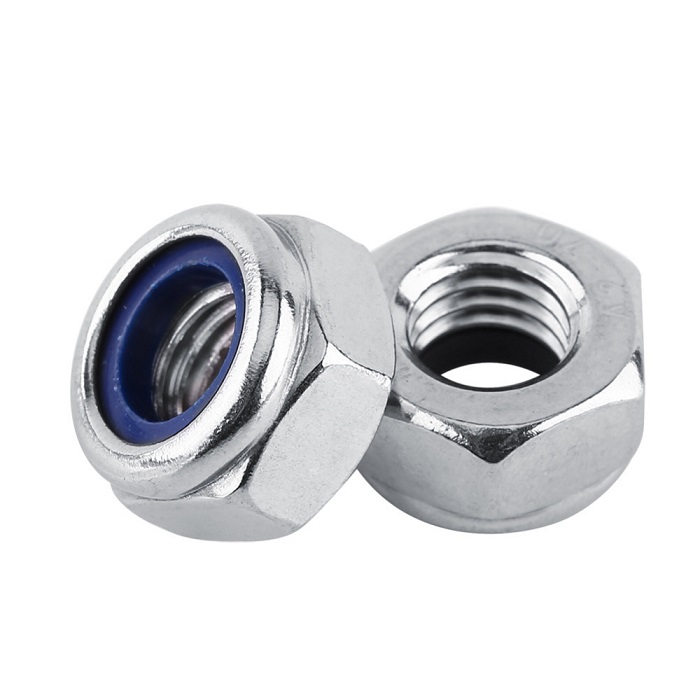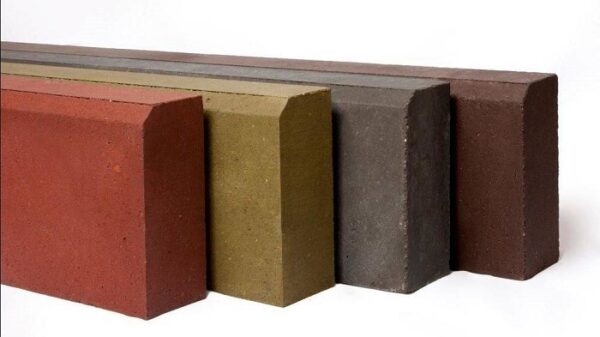There are many ways to connect parts in structures. One of these ways is to use threaded connections with self-locking nuts. They not only allow you to securely connect parts, but also prevent the joints from self-unscrewing during vibrations or other influences.
1. How do self-locking nuts work?2. What are torque-dominated nuts?3. Advantage over freewheel nuts4. Nut with nylon ring or all-metal?5. Deformed all-metal nuts6. Standards for self-locking nuts are common.7. Can self-locking nuts be reused?8. Where are self-locking nuts used?
1. How do self-locking nuts work?
Self-locking nuts are a specialized type of nut designed to prevent spontaneous loosening from a threaded rod during vibrations, shocks, or other dynamic loads. The basic principle of operation of such nuts is to create resistance or friction, which prevents the nut from turning freely along the thread.
Mechanisms of contradiction:
- Nylon Ring: Many self-locking nuts have a built-in nylon ring located at one end of the nut. When the nut is pulled through onto the threaded rod, the nylon ring is clamped, creating friction. This friction makes it difficult to unscrew the nut, making it “self-locking”.
- Thread deformation: Another method is to make a nut with a slightly warped thread. When the nut is pulled through onto the threaded rod, the deformed thread interacts with the thread of the rod, creating friction that prevents loosening.
- Use of special materials: Some self-locking nuts can be made of materials that have a high coefficient of friction, which further prevents them from coming loose.
Self-locking nuts provide additional confidence in the reliability of the threaded connection, especially in structures that are subjected to constant or intermittent loads. However, they should not be considered as the only method of ensuring the reliability of the connection; They are best used in combination with other methods of fixation and control.
2. What are torque-preferred nuts?
Torque-preferred nuts are a special type of self-locking nut that is designed in such a way that it requires more torsional force along the threaded rod throughout the tightening process, not just in the final stages as is often the case with traditional nuts.
The main features of torque-dominated nuts are:
- Constant Resistance: This type of nut provides stable resistance throughout the tightening process, allowing you to control the tightening torque and ensuring uniform tensioning.
- Extra Reliability: With constant resistance, these nuts reduce the risk of unscrewing as a result of vibration or dynamic loads.
- Design features: To achieve this constant resistance, nuts may have warped thread sections or special inserts that provide the required torque.
- Use in Critical Connections: Such nuts are often used in critical connections where it is important to ensure maximum reliability and safety.
Torque-preferred nuts are used in a number of industrial applications, especially where high connection reliability is required. They provide additional confidence that the nut will hold the threaded connection securely, regardless of the operating conditions.
3. Advantage over freewheel nuts
Freewheel nuts are common nuts that turn easily on the threaded rod until they reach their final position or before tightening begins. However, compared to self-locking nuts, they have certain disadvantages, especially when it comes to the reliability and stability of the connections. Let’s take a look at the main advantages of self-locking nuts over freewheel nuts:
1. Preventing Self-Unscrewing:
The main advantage of self-locking nuts is their ability to prevent self-unscrewing under the influence of vibrations, shocks or thermal fluctuations. Freewheel nuts can be unscrewed in such conditions without additional devices.
2. Stable Torque:
Self-locking nuts provide consistent torque throughout the tightening process, allowing for more precise control of the tightening force and more uniform tensioning.
3. Saving Time and Costs:
Installation of self-locking nuts can be quicker because it does not require additional locking elements or methods to secure the connection.
4. Improved Durability of Connections:
Due to their ability to prevent self-loosening, self-locking nuts can extend the life of threaded connections, reducing the risk of damage and breakage.
5. Security:
In critical applications where an unreliable connection can lead to serious consequences, self-locking nuts provide additional confidence in the safety and reliability of the connection.
Considering the above advantages, one can see why self-locking nuts have gained so much popularity in various industries, including automotive, construction, aviation, and others.
4. Nut with nylon ring or all-metal?
When it comes to self-locking nuts, the two main types most commonly found in the market are nylon ring nuts and all-metal nuts. Both types have their advantages and disadvantages, and the choice between them often depends on the specific application and reliability requirements.
Nylon Ring Nut:
- Principle of operation: The nut is equipped with a nylon ring at one of its ends. When tightened, the ring compresses, creating resistance that prevents the nut from coming loose.
- Advantages:
- Effective prevention of unscrewing due to friction between the nylon and the thread.
- Low cost compared to some other types of nuts.
- They can often be used in a wide range of temperatures.
- Disadvantages:
- The possibility of damage to the nylon ring at high temperatures or under the influence of chemicals.
- Limited service life, especially with frequent tightening/unscrewing cycles.
All-Metal Nut:
- Principle of operation: This type of nut has a deformed part or a specially designed thread that provides resistance when tightened.
- Advantages:
- High strength and durability, not susceptible to damage from temperatures or chemicals.
- Suitable for applications where high reliability is required.
- It can usually be reused without losing its properties.
- Disadvantages:
- Usually more expensive as compared to nylon ring nuts.
- May require more tightening force compared to traditional nuts.
Both types of nuts have their own places of application depending on the requirements for the part and operating conditions. Nylon ring nuts can be an excellent choice for applications where cost is important and where temperature or chemical conditions allow. All-metal nuts, on the other hand, may be the best choice for more demanding or critical applications.
5. Deformed all-metal nuts
Deformed all-metal nuts are fasteners that are made of all-metal material and have specific deformations on their surface or in the thread. These deformations are intentionally designed to provide additional friction when interacting with the threaded rod, which reduces the risk of unscrewing the nut.
Features of deformed all-metal nuts:
- Warped threads: In some models of such nuts, the thread may be deformed in the area, causing increased friction when the nut is tightened.
- Compressed Diameter: In other embodiments, the top diameter of the nut can be easily compressed, causing the nut thread to deform when it is pulled over the threaded rod.
- No Plastic: Because these nuts are completely metal, they are highly resistant to temperature and chemical influences, unlike nuts with nylon inserts.
Advantages of deformed all-metal nuts:
- Reliability: Due to the metal construction and deformed areas, these nuts hold the connection securely, even in difficult conditions.
- Endurance: They can withstand high temperatures and other extreme conditions without the risk of deformation or damage.
- Reuse: In many cases, deformed all-metal nuts can be safely used multiple times.
Disadvantages:
- Cost: All-metal nuts are usually more expensive than their nylon counterparts.
- Torque requirement: Torque specifications must be followed to ensure proper operation of the deformed nut.
In general use, deformed all-metal nuts can be an ideal choice for important structural connections, especially in environments where high strength and stability are required.
6. Common Standards for Self-Locking Nuts
Standardization is important to ensure quality, compatibility, and safety in any industry, especially in the field of fastener manufacturing. Self-locking nuts, like other fasteners, are subject to a number of standards developed by national and international organizations. Let’s take a look at some of the most common standards for self-locking nuts.
- ISO (International Organization for Standardization):
- ISO 10512: Standard for nuts with nylon insertion.
- ISO 7040/7042: Standard for Self-Locking Nuts with Nylon Ring.
- DIN (German National Standard):
- ASTM (American Society for Testing and Materials):
- ASTM F467: Standard Specification for Non-Ferritic Nuts for General Use.
- ASTM F468: Standard Specification for Non-Ferritic Fasteners.
- SAE (Society of Automotive Engineers):
- SAE J995: Specification for Mechanical and Material Requirements for Nuts.
- BS (British Standards):
- BS 4929: Standard for Self-Locking Thin Nuts.
- ANSI (American National Standard Institute):
- ANSI B18.16.3M: Standard for Self-Locking Nuts with Metric Threads.
In addition to these basic standards, there are also many other industry and corporate standards that take into account the specifics of specific applications and materials. Choosing the right standard depends on the specific application, requirements for strength, corrosion resistance, temperature resistance, and other factors.
7. Can self-locking nuts be reused?
Self-locking (or self-locking) nuts are designed to provide torsional resistance on a threaded rod, which prevents them from coming loose. But can they be reused?
1. Nylon Ring Nuts:
With each installation, the nylon ring is deformed to create the necessary resistance. This deformation may reduce the performance of the ring in subsequent cycles of use. While some nuts can be used multiple times, the nylon ring may lose its ability to effectively prevent the nut from coming loose.
2. Deformed all-metal nuts:
These nuts use metal deformations to create resistance. They tend to be less prone to wear and tear compared to nylon ring nuts and can be reused. However, if they have been subjected to excessive stress or used in conditions that may cause thread damage, reuse is not recommended.
3. Safety and Reliability:
The most important aspect is security. If there is any doubt about the condition of the self-locking nut, it must be replaced. The cost of a new nut is small compared to the risks associated with using a damaged or ineffective fastener.
While some self-locking nuts can be reused, it depends on the type of nut, its conditions of use, and its condition after dismantling. You should always follow the manufacturer’s recommendations and consider safety when deciding whether to reuse a nut.
8. Where are self-locking nuts used?
Self-locking nuts are a fastening material that provides a secure fixation, thanks to its special design that prevents unscrewing under the influence of vibrations, shocks or other dynamic loads. Here are some of the main applications of self-locking nuts:
1. Automotive:
In automobiles and other vehicles, vibrations are a common problem. Self-locking nuts are widely used to fasten engine parts, bodywork, undercarriage and other components to ensure their stability and safety during operation.
2. Construction:
In building structures, self-locking nuts can be used to fasten metal structures, fences, bridges and other structures where reliable fixation is required.
3. Aviation and Space:
In these industries, the requirements for the reliability and strength of connections are very high. Self-locking nuts are often used in the construction of aircraft, rockets, and other aerospace equipment.
4. Production Equipment:
Machinery and equipment that operate under high loads or vibrations may use self-locking nuts to ensure the stability and durability of their components.
5. Electronics:
In some electronic devices, especially those subject to movement or vibration, such nuts can be used to connect components.
6. Military Equipment:
In environments where high reliability is required and where equipment can be subjected to different loads, self-locking nuts become a key element of the design.
7. Home Use:
For home use, especially when assembling furniture or installing various structures, such nuts can provide additional stability and a long lifespan.
Self-locking nuts find their way into a variety of industries due to their unique ability to securely secure threaded connections. Thanks to this, they ensure the safety, stability and durability of structures in a wide variety of conditions.







